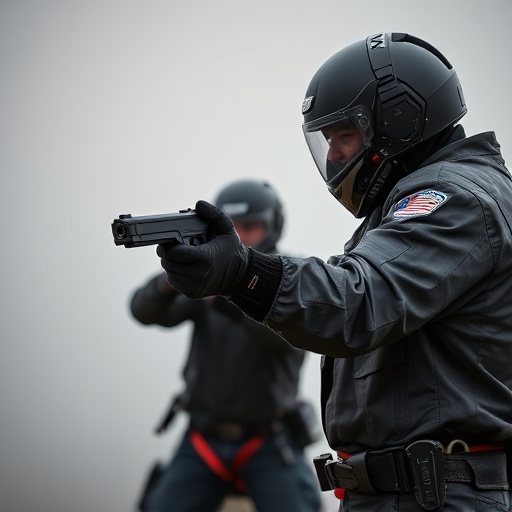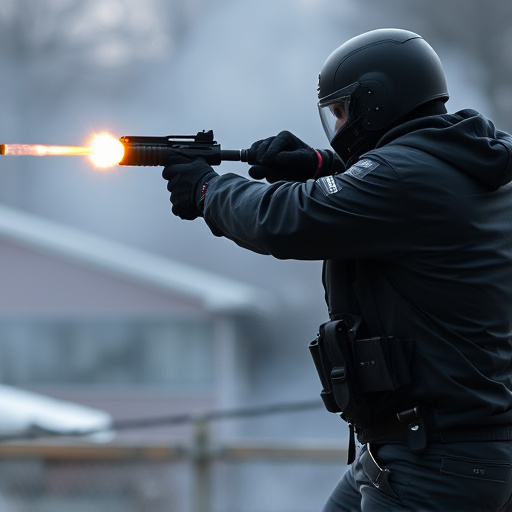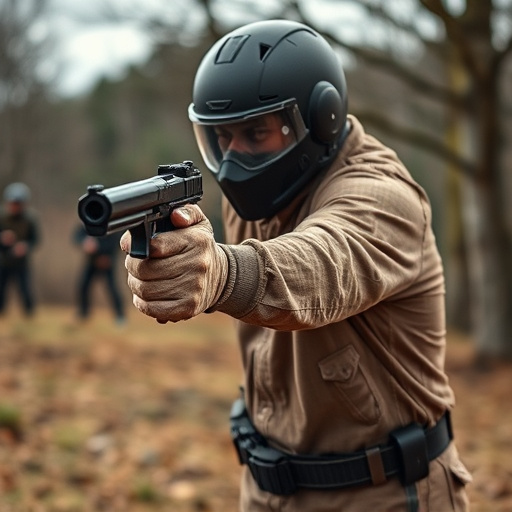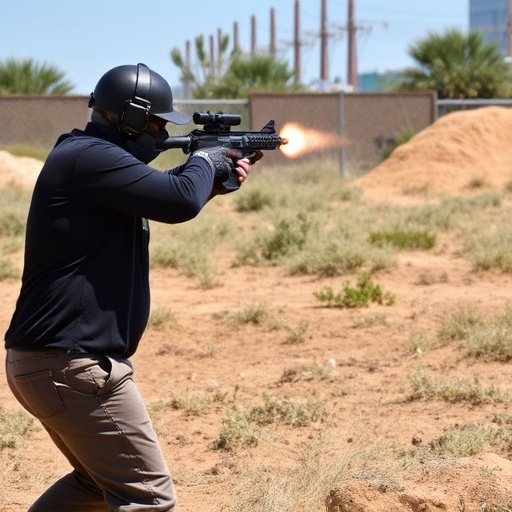Stun guns (electronic control devices – ECDs) use high-voltage, low-current electrical pulses (10,000 – 40,000 volts) to temporarily disable targets through muscle interference. The stun's effectiveness depends on voltage, current, and pulse frequency: higher frequencies penetrate deeper, disrupting nerves and muscles faster for a stronger shock; lower frequencies cause less immediate muscle interference but may require longer deployment times. Voltage is crucial, as higher levels induce stronger pulses that disrupt nerve signals, leading to severe spasms and temporary immobilization. Safety considerations focus on voltage limits (regulated globally) to prevent user or bystander harm due to high-voltage shocks. Future stun gun developments aim to enhance effectiveness through precise pulse delivery, lighter materials, and smart technology integration for improved safety and reliability in self-defense scenarios.
Stun guns, a popular non-lethal self-defense tool, utilize electrical pulses to incapacitate an attacker. This article delves into the intricacies of stun gun technology, focusing on the critical aspect of electrical pulse frequency and its impact on muscle interference. We explore how voltage plays a pivotal role in determining the device’s effectiveness. Understanding these factors is essential for consumers and law enforcement alike to make informed decisions regarding stun gun choice and safety.
- Understanding Stun Guns: A Brief Overview
- The Science Behind Electrical Pulse Frequency
- How Voltage Affects Muscle Interference
- Factors Influencing Stun Gun Effectiveness
- Safety and Regulatory Considerations
- Future Trends in Stun Gun Technology
Understanding Stun Guns: A Brief Overview

Stun guns, also known as electronic control devices (ECDs), are non-lethal weapons designed to temporarily incapacitate a target through electrical muscle interference. They operate by delivering a powerful electric pulse to the body, disrupting normal muscle function and causing intense pain, disorientation, and temporary paralysis. The key to their effectiveness lies in the frequency and voltage of the electrical pulses.
These devices typically use high-voltage, low-current electrical charges, often ranging from 10,000 to 40,000 volts, although specific figures can vary significantly among models. This high voltage is crucial for penetrating the skin and stimulating muscles, while the low current ensures minimal risk of permanent harm. The pulse frequency also plays a role in stun gun performance; higher frequencies can lead to more efficient muscle interference, but lower frequencies might be necessary for certain applications, such as incapacitating larger or more resistant targets.
The Science Behind Electrical Pulse Frequency

The effectiveness of a stun gun relies heavily on its electrical pulse frequency, which directly impacts how it interacts with the human body’s electrical system. Stun guns deliver high-voltage electrical pulses to disrupt muscle control, causing the target to experience severe pain and temporary incapacitation. The voltage itself is not enough; however; it’s the frequency that determines how successfully the electric current interferes with muscular functions.
At higher frequencies, the stun gun’s pulse can penetrate deeper into the body, affecting nerve impulses and muscles more efficiently. This results in a quicker and more powerful shock. Conversely, lower frequencies may produce less muscle interference, leading to longer deployment times but potentially less intense effects. Thus, manufacturers often prioritize specific frequency ranges to ensure their stun guns deliver both rapid and potent stun effects for effective self-defense.
How Voltage Affects Muscle Interference

The voltage delivered by a stun gun plays a critical role in determining the level of muscle interference experienced by the target. Higher voltage levels result in more intense electrical pulses, which can cause significant disruption in muscular function. This interference disrupts nerve signals, leading to loss of control over muscles and, ultimately, incapacitation.
In stun guns, voltage is essential for generating enough energy to overcome the body’s natural protective mechanisms against electric shock. As voltage increases, so does the potential for severe muscle contractions and spasms. These involuntary movements can render an individual temporarily immobilized, making them vulnerable to law enforcement or self-defense situations. Understanding how voltage impacts muscle interference is crucial for users to gauge the effectiveness of stun guns and make informed decisions regarding their use.
Factors Influencing Stun Gun Effectiveness

The effectiveness of a stun gun, measured by its impact on an opponent, is influenced by several key factors. One of the primary considerations is voltage—higher voltage generally translates to more powerful electrical pulses, which can result in faster muscle interference and immobilization. However, it’s not just about power; the design and quality of the stun gun play a significant role as well. A well-designed device ensures that the electrical current flows efficiently through the body, disrupting muscular control effectively.
Additionally, the size and shape of the stun gun can affect its performance. Smaller devices may offer quicker deployment but might not deliver the same level of muscle interference as larger models with longer probes. Weather conditions and the target’s physical attributes also come into play. Moisture on the skin or clothing can interfere with current flow, while body fat distribution can impact the intensity of the electrical pulse experienced by muscles.
Safety and Regulatory Considerations

Stun guns, despite their non-lethal nature, require careful consideration regarding safety and regulatory aspects. One critical factor is the electrical pulse frequency and its impact on the human body. The intensity of a stun gun’s shock depends on two primary factors: voltage and current. While higher voltages are more effective in delivering a powerful jolt, they also raise concerns about potential muscle interference and safety risks for users and bystanders.
Regulatory bodies worldwide have established guidelines to ensure these devices are safe for intended use. These regulations dictate maximum allowed voltages and currents, often with a focus on minimizing the risk of serious injury or permanent damage to muscles and nerves. It’s essential for stun gun manufacturers to adhere to these standards to guarantee user safety and prevent any adverse effects associated with high-voltage shocks.
Future Trends in Stun Gun Technology

The future of stun gun technology looks promising, with a focus on enhancing effectiveness and user safety. One area of interest is the development of more precise electrical pulse frequencies. Currently, stun guns use high-voltage electrical pulses to disrupt muscle function, but these pulses can sometimes cause discomfort or even injury if not delivered correctly. By refining the frequency and duration of these pulses, manufacturers aim to deliver a more targeted shock, minimizing damage while maximizing stun effectiveness.
Additionally, advancements in materials science may lead to lighter and more durable stun guns. Reducing weight without compromising power can make these devices easier to carry and deploy in emergency situations. The integration of smart technology, such as sensors and advanced control systems, could also enable stun guns to adapt to different body types and movement, ensuring a more reliable and consistent stun effect across various users. These future trends hint at a safer and more efficient arsenal of personal defense tools, leveraging the power of electricity while mitigating potential risks.
Stun guns, as a non-lethal self-defense tool, rely on precise electrical pulse frequency and voltage to achieve effective muscle interference. Understanding these factors, along with their interactions, is key to maximizing stun gun effectiveness while ensuring safety and regulatory compliance. As technology advances, future trends in stun gun design will continue to enhance performance and incorporate innovative features, ultimately improving personal protection capabilities.
